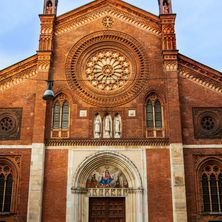

Although it is not among the most important shrines in the city, the Church of St Mark is definitely one of the oldest. Its foundation goes back to the 12th century, when the Milanese constructed a church in honor of the patron saint of Venice, the state that helped liberate Milan from the rule of Emperor Frederick Barbarossa. However, the first complete church to stand on the spot was built in the middle of the 13th century by the Augustinian monks. That edifice was elaborated in the Baroque style four hundred years later, becoming the second largest church in Milan, after the Duomo.
In 1770 a fourteen-year-old composer from Salzburg by the name of Wolfgang Amadeus Mozart resided for three months in the church's monastery, gathering inspiration from the Lombard capital. A century later, in 1874, the local orchestra played Giuseppe Verdi's Requiem, written in honor of the first anniversary of the death of eminent Milanese poet and novelist Alessandro Manzoni.
The architectural layout of the church is typical of the Gothic style. The oldest original structure is the bell tower, which dates back to the 14th century, yet it was restored towards the end of the 19th century. The façade was also restored in that period, by architect Carlo Maciachini, an important representative of the Eclectic School. Maciachini preserved the marble portal with the tympanum containing the mosaic lunette depicting the Madonna and Saints. He also kept the rose window and the three statues standing over the portal, which are attributed to sculptor Giovanni di Balduccio.
Although the church's façade is Gothic, the interior is perfectly Baroque. It has one central nave and two aisles. In the Foppa Chapel, the first on the right, we will find frescoes by Lombard artist from the mannerist school, Gian Paolo Lomazzo. The dome shows the Glory of Angels, the Fall of Simon Magus adorns the left wall and St Paul Revives a Dead Man graces the right.
Another interesting section of the church is the right transept. It contains an early 17th-century fresco painted by brothers Giovanni Battista and Giovanni Mauro Della Rovere, who are more commonly known as the Fiammenghini. The fresco depicts Pope Alexander IV instituting the Augustinian order. But what is more fascinating than the fresco itself is the fact that it was painted right over a 14th century fresco depicting the Crucifixion. This older fresco, attributed to Anovelo da Imbonate, was discovered only in 1956 and was partially restored in order to distinguish it from the former one.
Besides several other artworks executed by northern Italian artists, the church also houses the tombs and sarcophagi containing the remains of several members of the Aliprandi family, an important clan of jurists who participated in the government of Milan in the 13th and 14th centuries.